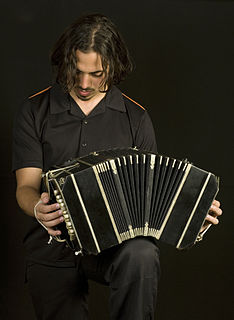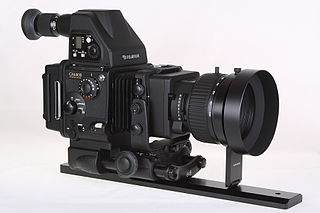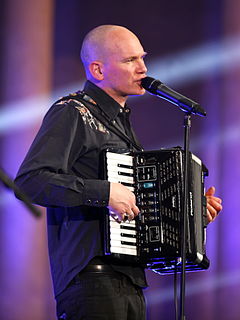External links
- Ливенская гармошка (Livenskaya garmoshka), in Russian
| | This article relating to free reed aerophones is a stub. You can help Wikipedia by expanding it. |
File:Livenskaya accordion.jpg Snka is a local variety of Russian accordion, which appeared in the city of Livny Oryol province in the 1870s{{sfn|Mirek A. Handbook to the harmonica scheme|1992} }.The name of the inventor of the livenka was not preserved. It is believed to have been developed in the second half of the 19th century as a modification of existing German or Russian button accordions.

Accordions are a family of box-shaped musical instruments of the bellows-driven free-reed aerophone type, colloquially referred to as a squeezebox. A person who plays the accordion is called an accordionist. The concertina, harmoneon and bandoneón are related. The harmonium and American reed organ are in the same family, but are typically larger than an accordion and sit on a surface or the floor.

The bandoneon is a type of concertina particularly popular in Argentina and Uruguay. It is a typical instrument in most tango ensembles. As with other members of the concertina family, the bandoneon is held between the hands, and by pulling and pushing actions force air through bellows and then routing air through particular reeds as by pressing the instrument's buttons. Bandoneons have a different sound from accordions, because bandoneons do not usually have the register switches that are common on accordions. Nevertheless, the tone of the bandoneon can be changed a great deal using varied bellows pressure and overblowing, thus creating potential for expressive playing and diverse timbres.

A free reed aerophone is a musical instrument that produces sound as air flows past a vibrating reed in a frame. Air pressure is typically generated by breath or with a bellows. In the Hornbostel–Sachs system, it is number: 412.13. Free reed instruments are contrasted with non-free or enclosed reed instruments, where the timbre is fully or partially dependent on the shape of the instrument body, Hornbostel–Sachs number: 42.

A Chemnitzer concertina is a musical instrument of the hand-held bellows-driven free-reed category, sometimes called squeezeboxes. The Chemnitzer concertina is most closely related to the bandoneón, more distantly to the other concertinas, and accordions.

The term squeezebox is a colloquial expression referring to any musical instrument of the general class of hand-held bellows-driven free reed aerophones such as the accordion and the concertina. The term is so applied because such instruments are generally in the shape of a rectangular prism or box, and the bellows is operated by squeezing in and drawing out.

The garmon, commonly called garmoshka, is a kind of Russian button accordion, a free-reed wind instrument. A garmon has two rows of buttons on the right side, which play the notes of a diatonic scale, and at least two rows of buttons on the left side, which play the primary chords in the key of the instrument as well as its relative harmonic minor key. Many instruments have additional right-hand buttons with useful accidental notes, additional left-hand chords for playing in related keys, and a row of free-bass buttons, to facilitate playing of bass melodies.

The trikititrikitixa, or eskusoinu txiki ) is a two-row Basque diatonic button accordion with right-hand rows keyed a fifth apart and twelve unisonoric bass buttons. The onomatopoeia trikitixa, apparently stemming from the sound emitted by the tambourine, originally referred to a traditional Basque ensemble, made up of the instrument which now bears the name as well as alboka, txistu and other instruments.

A button accordion is a type of accordion on which the melody-side keyboard consists of a series of buttons. This differs from the piano accordion, which has piano-style keys. Erich von Hornbostel and Curt Sachs categorize it as a free reed aerophone in their classification of instruments, published in 1914. The sound from the instrument is produced by the vibration of air in reeds. Button accordions of various types are particularly common in European countries and countries where European people settled. The button accordion is often confused with the concertina; the button accordion's buttons are on the front of the instrument, where as the concertina's are on the sides and pushed in parallel with the bellows.

A piano accordion is an accordion equipped with a right-hand keyboard similar to a piano or organ. Its acoustic mechanism is more that of an organ than a piano, as they are both aerophones, but the term "piano accordion"—coined by Guido Deiro in 1910—has remained the popular name. It may be equipped with any of the available systems for the left-hand manual.

Chord organ is a kind of home organ that has a single short keyboard and a set of chord buttons, enabling the musician to play a melody or lead with one hand and accompanying chords with the other, like the accordion with a set of chord buttons which was originated from a patent by Cyrill Demian in 1829, etc.

The Flutina is an early precursor to the diatonic button accordion, having one or two rows of treble buttons, which are configured to have the tonic of the scale, on the "draw" of the bellows. There is usually no bass keyboard: the left hand operates an air valve. A rocker switch, called a "bascule d'harmonie" is in the front of the keyboard. When this switch is thumb activated, it would open up a pallet (a pad that covers a tone hole, at the other end of the key button, for a simple Tonic/Dominant drone: Tonic on the draw and Dominant on the press, e.g. Tonic notes C/g, and Dominant G/d, without any major or minor thirds.

A melodeon or diatonic button accordion is a member of the free-reed aerophone family of musical instruments. It is a type of button accordion on which the melody-side keyboard contains one or more rows of buttons, with each row producing the notes of a single diatonic scale. The buttons on the bass-side keyboard are most commonly arranged in pairs, with one button of a pair sounding the fundamental of a chord and the other the corresponding major triad.
The Saratovskaya garmonika, named after the Russian city of Saratov, is a colorful variant on the standard one row push–pull diatonic button accordion. The chief distinguishing characteristic of this little folk accordion is that it plays the tonic scale on the bellows draw and the dominant on the bellows press, the reverse of a standard diatonic box. Another curious feature is the addition of two bells on the top of the instrument which are struck with tiny metal hammers attached to the bass and chord buttons for rhythmic accompaniment. They add a fun accent on dance tunes. It is possible to play the basses very lightly and avoid activating the bells, as they become rather tiresome after a while. The basses also have an additional tonic chord button in the center, lighter in tone than the regular chord, which is not attached to the hammers.

The Stradella Bass System is a buttonboard layout equipped on the bass side of many accordions, which uses columns of buttons arranged in a circle of fifths; this places the principal major chords of a key in three adjacent columns.

A free-bass system is a system of left-hand bass buttons on an accordion, arranged to give the performer greater ability to play melodies with the left-hand and form one's own chords. The left-hand buttonboard consists of single-note buttons with a range of three octaves or more, in contrast to the standard Stradella bass system, which offers a shorter range of single bass notes, plus preset major, minor, dominant seventh, and diminished chord buttons. The term "free-bass system" refers to various left-hand manual systems that provide this functionality: The Stradella system does not have buttons for different octaves of the bass notes, which limits the types of melodies and basslines that can be performed with the left hand.

The Steirische Harmonika is a type of bisonoric diatonic button accordion important to the alpine folk music of Croatia, Slovenia, the Czech Republic, Austria, the German state of Bavaria, and the Italian South Tyrol. The Steirische Harmonika is distinguished from other diatonic button accordions by its typically richer bass notes, and by the presence of one key per scale row that has the same tone on both compression and expansion of the bellows, called a Gleichton. The bass notes earn the distinction Helikonbässe because they use bigger reeds with duralumin reed frames and a special chamber construction that amplifies its bass tones to give it a loud sound reminiscent of a Helicon tuba.

The kalyuka is a Russian and Ukrainian overtone flute, lacking playing holes. Traditionally, kalyukas were made from hollow plant stems, such as motherwort, or angelica. Modern versions of the instrument are usually made from PVC, an inexpensive and durable substitute.

The Fuji GX680 is a series of single lens reflex system cameras for medium format film produced by Fujifilm with interchangeable camera lenses and interchangeable film holders for the unusual film format 6×8 cm on 120 and 220 roll film. The distinguishing feature of the Fuji GX680 is the articulating front standard, which runs on a rail connecting lens and camera body by a bellows; the interchangeable lens is permanently mounted to a lens board.

Khromka is a type of Russian garmon. It is the most widespread variant in Russia and in the former USSR. Nearly all Russian garmons made since the mid of the 20th century are khromkas.

A digital accordion is an electronic musical instrument that uses the control features of a traditional accordion to trigger a digital sound module that produces synthesized or digitally sampled accordion sounds or, in most instruments, a range of non-accordion sounds, such as orchestral instruments, pipe organ, piano, guitar, and so on. Digital accordions typically encode and transmit key presses and other input as Musical Instrument Digital Interface (MIDI) messages. Most digital accordions need to be plugged into a keyboard amplifier or PA system to hear their sounds.